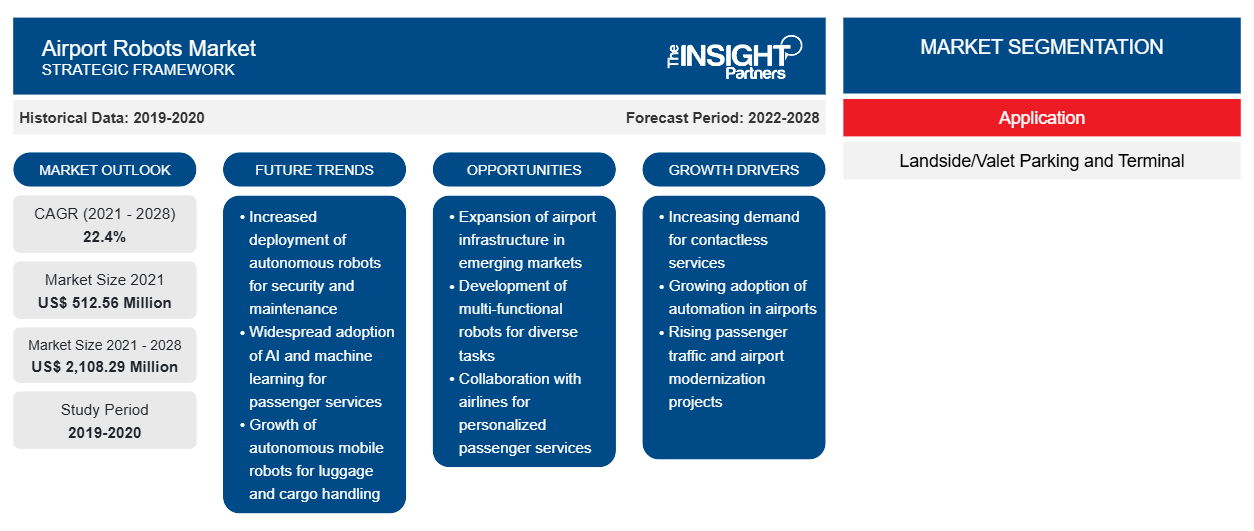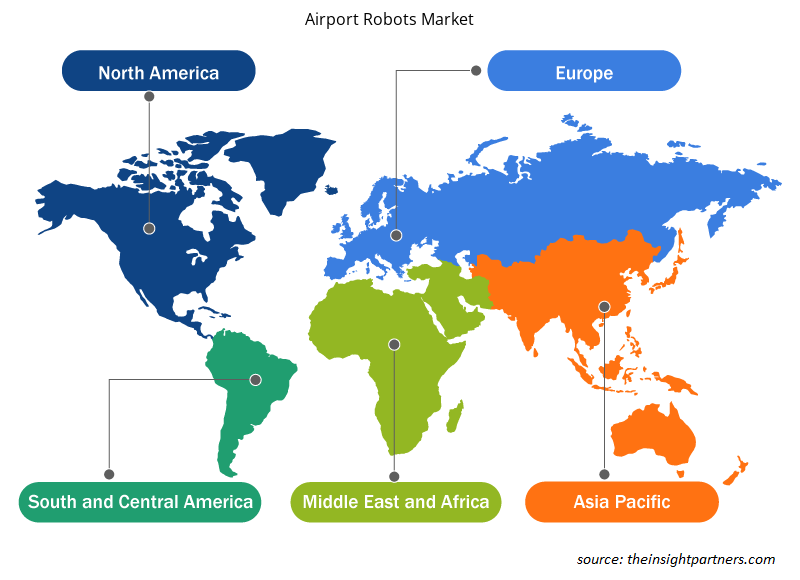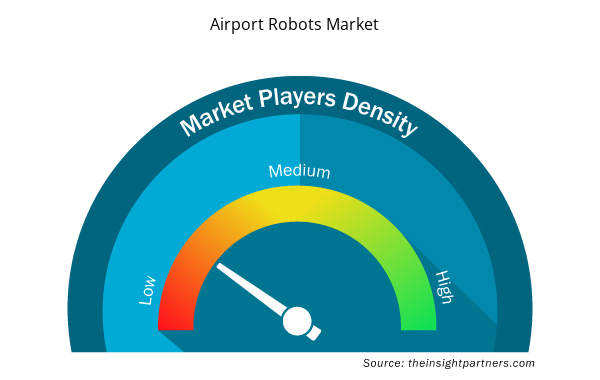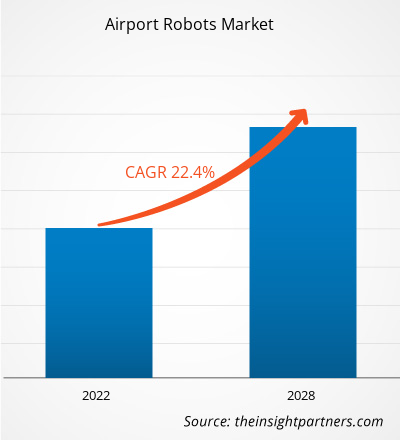[Research Report] The airport robots market is expected to grow from US$ 512.56 million in 2021 to US$ 2,108.29 million by 2028; it is estimated to grow at a CAGR of 22.4% from 2021 to 2028.
With the rise in real and perceived threats to the national security, continuous efforts are being taken to come up with innovative active interrogation approaches to identify these threats. The most instant perceived threats and their essential materials comprise conventional explosives, weapons, chemical agents, and contraband. With an intent to prevent uncertain events, authorities worldwide are actively focusing on the deployment of advanced systems, including robots, to strengthen security at airports. The robots used for security application at airports are integrated with features such as facial recognition systems, sensors, and cameras to measure pulse rate remotely, which allows them to detect suspicious persons, currencies, weapons and explosives, abandoned objects, and other illicit material without disturbing the operations or flow of passengers at airports. Furthermore, the governments of various countries are investing in the development of their transport infrastructure, including building of new airports. For instance, the Chinese government plans to construct additional 215 airports by 2035. Furthermore, the Indian government plans to build 100 new airports across the country by 2024.
Customize This Report To Suit Your Requirement
You will get customization on any report - free of charge - including parts of this report, or country-level analysis, Excel Data pack, as well as avail great offers and discounts for start-ups & universities
Airport Robots Market: Strategic Insights

- Get Top Key Market Trends of this report.This FREE sample will include data analysis, ranging from market trends to estimates and forecasts.
Customize This Report To Suit Your Requirement
You will get customization on any report - free of charge - including parts of this report, or country-level analysis, Excel Data pack, as well as avail great offers and discounts for start-ups & universities
Airport Robots Market: Strategic Insights

- Get Top Key Market Trends of this report.This FREE sample will include data analysis, ranging from market trends to estimates and forecasts.
Impact of COVID-19 Pandemic on Airport Robots Market
The COVID-19 pandemic and the consequent containment measures have marginally impacted the airport robots market in 2020, as it led to temporary halts in the manufacturing processes. However, with the gradual resumption of manufacturing processes from the third quarter of 2020, the demand for airport robots has begun to rise; thus, manufacturers managed to stabilize the overall revenue and cashflow.
Airport Robots Market Insights
Increase in Demand for Advanced Robots is Fueling Growth of Airport Robots Market
OEMs have been investing in R&D to develop best in class and advanced robots. Enormous daily foot traffic experienced by airports over the last decade is compelling them to optimize various operations at airports. With many companies offering airport robots for simplifying these operations, airports are shifting their focus on adopting autonomous robots to optimize labor, enhance operational performance, mitigate risk, and improve traveler experiences. As a result, many of them are looking forward to partnering with robot suppliers that can offer the best in class advanced robots for applications such as security, luggage handling, passenger guidance, and cleaning.
Application-Based Market Insights
The airport robots market, by application, is segmented into landside/valet parking and terminal. The terminal segment led the airport robots market in 2020. An airport terminal is a building at an airport where passengers arrive upon landing and also depart on a flight. Typically, terminals have several gates divided into sections known as concourses that are filled with shopping, dining, restroom, lounge, and other facilities. Passengers at terminals can purchase tickets, check in for the scheduled flight, check or collect luggage, pass through security or customs, find connecting flights, and others.
The players operating in the airport robots market focus on strategies such as mergers & acquisitions and market initiatives to maintain their position in the market. A few developments by key players are listed below:
- In 2021, SITA announced that it has completed the installation of its next-generation passenger processing infrastructure at Václav Havel Airport Prague, setting the path for a future passenger journey that is fully touch less and mobile.
- In 2020, the deployment of the world's first outdoor car park totally operated by robots, built by Stanley Robotics and VINCI Airports, continues at Lyon Airport, with the number of accessible places anticipated to expand from 500 to 2,000. Seven autonomous robots will operate the service at the same time, with 28 cabins accessible for dropping off and picking up vehicles.
Airport Robots Market Regional Insights
The regional trends and factors influencing the Airport Robots Market throughout the forecast period have been thoroughly explained by the analysts at Insight Partners. This section also discusses Airport Robots Market segments and geography across North America, Europe, Asia Pacific, Middle East and Africa, and South and Central America.

- Get the Regional Specific Data for Airport Robots Market
Airport Robots Market Report Scope
| Report Attribute | Details |
|---|---|
| Market size in 2021 | US$ 512.56 Million |
| Market Size by 2028 | US$ 2,108.29 Million |
| Global CAGR (2021 - 2028) | 22.4% |
| Historical Data | 2019-2020 |
| Forecast period | 2022-2028 |
| Segments Covered |
By Application
|
| Regions and Countries Covered | North America
|
| Market leaders and key company profiles |
Airport Robots Market Players Density: Understanding Its Impact on Business Dynamics
The Airport Robots Market market is growing rapidly, driven by increasing end-user demand due to factors such as evolving consumer preferences, technological advancements, and greater awareness of the product's benefits. As demand rises, businesses are expanding their offerings, innovating to meet consumer needs, and capitalizing on emerging trends, which further fuels market growth.
Market players density refers to the distribution of firms or companies operating within a particular market or industry. It indicates how many competitors (market players) are present in a given market space relative to its size or total market value.
Major Companies operating in the Airport Robots Market are:
- YUJIN ROBOT Co., Ltd.
- Avidbots Corp.
- CYBERDYNE INC.
- SoftBank Robotics
- Stanley Robotics SAS
Disclaimer: The companies listed above are not ranked in any particular order.

- Get the Airport Robots Market top key players overview
The global airport robots market has been segmented as follows:
Airport Robots Market – by Application
- Landside/Valet Parking
- Terminal
Airport Robots Market – by Geography
North America
- US
- Canada
- Mexico
Europe
- France
- Germany
- Italy
- Russia
- UK
- Rest of Europe
Asia Pacific (APAC)
- China
- India
- Japan
- Australia
- South Korea
- Rest of APAC
Middle East & Africa (MEA)
- Saudi Arabia
- UAE
- South Africa
- Rest of MEA
South America (SAM)
- Brazil
- Rest of SAM
Company Profiles
- YUJIN ROBOT Co., Ltd.
- Avidbots Corp.
- Cyberdyne Inc.
- SoftBank Robotics
- Stanley Robotics SAS
- SITA
- ABB Ltd.
- ECA Group
- LG Electronics
- UVD Robots
- Historical Analysis (2 Years), Base Year, Forecast (7 Years) with CAGR
- PEST and SWOT Analysis
- Market Size Value / Volume - Global, Regional, Country
- Industry and Competitive Landscape
- Excel Dataset



Report Coverage
Revenue forecast, Company Analysis, Industry landscape, Growth factors, and Trends

Segment Covered
Application and Geography

Regional Scope
North America, Europe, Asia Pacific, Middle East & Africa, South & Central America

Country Scope
Australia, Brazil, Canada, China, France, Germany, India, Italy, Japan, Mexico, Russian Federation, Saudi Arabia, South Africa, South Korea, United Arab Emirates, United Kingdom, United States
Frequently Asked Questions
Original equipment manufacturers (OEMs) have been investing in research and development (R&D) to develop best in class and advanced robots. Enormous daily foot traffic experienced by airports over the last decade is compelling them to optimize various operations at airports. With many companies offering airport robots for simplifying these operations, = airports are shifting their focus on adopting autonomous = robots to optimize labor, enhance operational performance, mitigate risk, and improve traveler experiences. As a result, many of them are looking forward to partnering with robot suppliers that can offer the best in class advanced robots for applications such as security, luggage handling, passenger guidance, and cleaning. Moreover, airports are facing issues in terms of significantly rising labor costs as well as the shortage of qualified, experienced, and reliable employees. Thus, the burgeoning complexity of airport operations is resulting in overburdening of existing personnel, compelling them to make tradeoffs between the quantity and quality of their work, which might hamper their reputation. To address this issue, airports are switching toward more advanced and autonomous robots that not only reduce the burden on personnel, but also work more efficiently than humans, without facing the issues such as excessive workload and fatigue.
Developing countries have become a hub of opportunities for various markets, including airport robots market. Government authorities in these countries are planning and investing huge amount in the advancement of technologies to improve the overall infrastructure. Transportation and logistics activities are huge contributors to the development of any country, and therefore, developing countries are extensively focusing on enhancing and improving their transportation and logistics infrastructure, including air, road, and sea transport. Airways is an important mode of transportation; hence, governments of developing countries have planned development and revamping of various mid-size and large airports. For instance, in India, Netaji Subhas Chandra Bose International Airport in Kolkata has laid down expansion plan of the airport. Similarly, Vietnam is planning to build one of the largest airports near its economic hub Ho Chi Minh City. Other developing countries including the Philippines and Kuwait are also expanding and revamping airports. As a part of expansion and revamping strategy, these airports would also be passing tenders on acquiring technologically advanced equipment including robots for ensuring convenience and providing superior experience to passengers. Hence, the airport robot market players have huge opportunities to offer best-in-class, and highly reliable and cost-efficient robots for such new airport projects.
The terminal segment led the airport robots market with a share of 74.8% in 2020. It is further expected to account for 77.0% of the total market by 2028.
The airport robots market is led by terminal segment with highest share and is expected to dominate in the forecast period. An airport terminal is a building at an airport where passenger arrive upon landing and depart on a flight. Typically, terminals have several gates divided into sections known as concourses that are filled with shopping, dining, restroom, lounge, and other facilities. Passengers at terminals can purchase tickets, check in for the scheduled flight, check or collect luggage, pass through security or customs, find connecting flights, and others.
ABB Ltd; Cyberdyne Inc.; LG Electronics Inc.; SoftBank Corp.; and Stanley Robotics SAS are among the key companies with significant market share.
The overall cost of procuring and maintaining advanced robots is quite high, which limits their adoption at airport, especially in cost-sensitive countries. These robots require frequent maintenance and servicing, which adds to the overall operating cost of running an airport. Airport deploy a large number of such advanced systems for various operations, based on the size and the requirement of the airport, and with the multiple deployments, the overall procurement and maintenance cost increases further. Small airports, operating in developed and developing countries, therefore, resist deploying such high-end robots and rely on conventional practices. Considering this restraint, airport robot manufacturers need to focus on offering a range of robots, starting from low end to high end, without compromising on the incorporation of the necessary and vital features in the low- and mid-range robots. The COVID-19 pandemic has changed the ways of operations of various sectors, including the transportation sector and airport industry. Airport authorities are willing to deploy autonomous robots to, ultimately, meet the social distancing norms imposed by the respective governments; however, the initial costs and maintenance costs are limiting their investments in robotic solutions.
Trends and growth analysis reports related to Electronics and Semiconductor : READ MORE..
The List of Companies - Airport Robots Market
- YUJIN ROBOT Co., Ltd.
- Avidbots Corp.
- CYBERDYNE INC.
- SoftBank Robotics
- Stanley Robotics SAS
- SITA
- ABB Ltd
- ECA Group
- LG Electronics
- UVD ROBOTS

 Get Free Sample For
Get Free Sample For